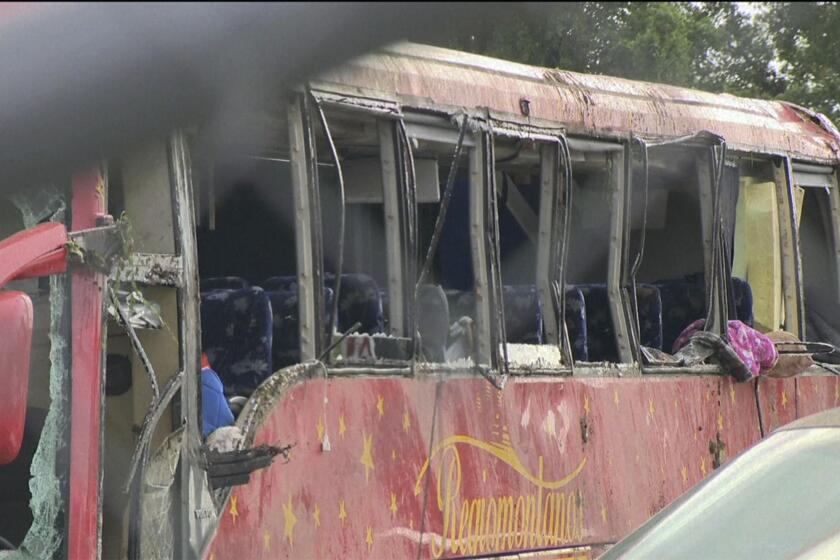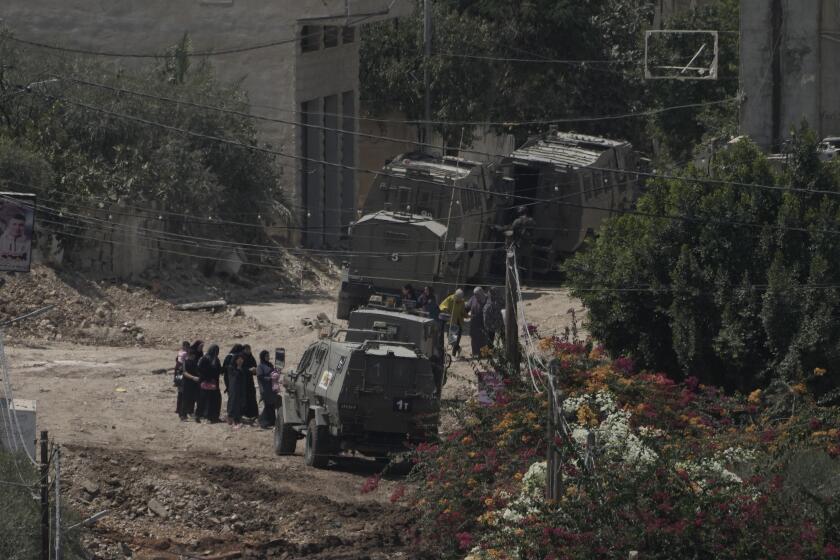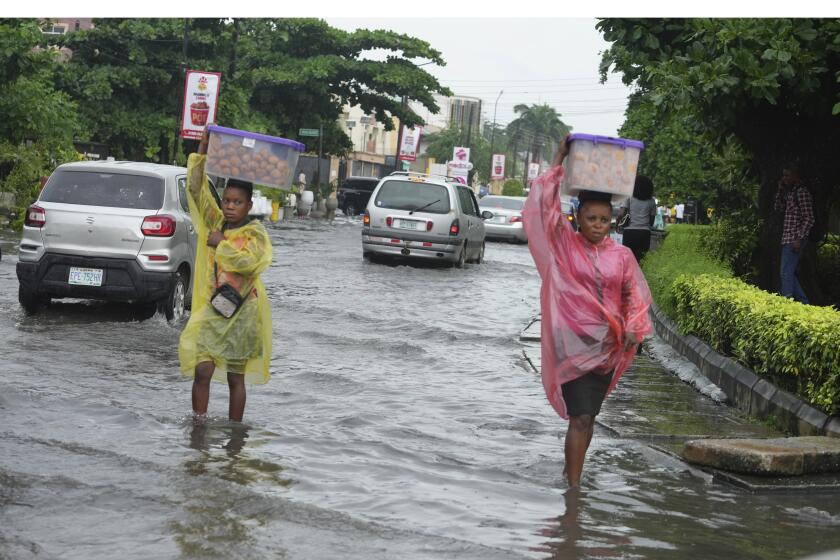Higher Iraqi Tank Losses Reported; 4th Carrier in Gulf : Attack options: The United States will consider announcing bomb targets in advance to avoid killing civilians, general says after Baghdad air raid.
The United States declared significant gains Thursday in destroying Iraqi tanks and combat vehicles as an additional U.S. aircraft carrier moved into the Persian Gulf in preparation for a possible Marine amphibious landing soon.
The carrier America joined three other U.S. aircraft carriers in the narrow Gulf waterway, filling out a core naval force that would provide air support for an 18,000-man amphibious assault that could take place in days rather than weeks, defense officials said.
The officials, who asked to remain anonymous, said the battleship Missouri began shelling the coast of occupied Kuwait this week for the second time in the war. Minesweepers prepared to clear Kuwaiti coastal waters of planted explosives that could disrupt a Marine landing, one Pentagon official said.
As indications of coming ground action mounted, military officials in Washington and at Central Command headquarters in Riyadh, Saudi Arabia, said intense allied air attacks were taking a high toll on Iraqi armor, seen as the chief impediment to a ground assault from Saudi Arabia into occupied Kuwait.
Lt. Gen. Thomas W. Kelly, operations director for the Joint Chiefs of Staff at the Pentagon, called the status of Iraqi ground troops “precarious” and said that up to 45% of all Iraqi combat vehicles are now believed to be destroyed or disabled.
Military officials have said a ground offensive can begin when half of Iraq’s combat vehicles and other equipment are destroyed. In recent days, however, they said an attack might come sooner if allied warplanes isolate Iraqi ground units from each other and from Baghdad.
In other developments:
The United States said it will consider announcing bomb targets in advance to avoid killing civilians. Marine Brig. Gen. Richard I. Neal said this is “one of many options that we’re exploring.” Hundreds of civilians were reported killed Wednesday in Baghdad when the United States bombed what it said was a military bunker. The Iraqis said the facility was a civilian bomb shelter.
Rescue workers had recovered 288 charred bodies from the structure by Thursday night, according to Dr. Faiq Bakr, director of the government mortuary in Baghdad. He said 91 of the dead were children. Recovery work was continuing. The Iraqi government had said the day before that the victims numbered 500. Bakr said 94 of the bodies were so badly burned that they could not be identified, even by sex.
Iraq fired two Scud missiles at Saudi Arabia. They apparently broke up in flight, allied officers said. The missiles fell on the town of Hafar al Batin, 45 miles south of the Saudi-Iraqi border, where allied tanks were rumbling across the desert in a huge battle exercise. They were not hit, but debris from the missiles injured four Saudi civilians, none seriously.
Some of the Iraqis who have flown their warplanes to safe haven in Iran have asked for political asylum, said Iranian Foreign Minister Ali Akbar Velayati. He did not say how many or whether their requests would be granted. But he reiterated that the planes, which the United States says now number more than 140, will remain in Iran until after the war.
The possibility of an amphibious landing, U.S. Marine sources have said, would be part of a strategy to maneuver around Iraqi forces that had been cut off from each other and from their commanders in Baghdad.
While one Marine officer said recently that such an assault was 95% certain, some continue to believe that the amphibious landing would be a feint designed to tie down Iraqi forces along the Kuwaiti coast while allied ground troops attack elsewhere.
If such a landing is attempted, military sources said, it most likely would be launched on a night when the tide is high and there is no moon to light the beaches. The next window for such a rare combination of conditions, officials said, opens today.
Defense officials in Washington told the Reuters news agency that American planes have started dropping 15,000-pound fuel-air bombs to clear minefields near the Saudi-Kuwaiti border.
It was said to be another sign that a ground assault might begin soon.
Allied Gains
In Riyadh, Gen. Neal, who is deputy operations director for the Central Command, told reporters that the allies have destroyed a total of 1,300 Iraqi tanks--a little less than a third of the 4,280 tanks that Iraq possessed at the beginning of the war in the Kuwaiti theater of operations.
In addition, more than 800 Iraqi armored vehicles and 1,100 artillery pieces have been destroyed since the beginning of the war, Neal said.
But the U.S. Air Force suffered a new loss.
An American electronic-jamming and radar-detection jet crashed in northern Saudi Arabia, apparently after being damaged in combat, Neal reported. He identified the plane as an EF-111A Raven and said its two crew members were killed.
Their ejection capsule and the wreckage of the plane were found early Thursday, Neal said, near the Saudi-Iraqi border.
The plane was the 19th American and 27th allied loss since the beginning of the war.
Allied jets flew more than 2,800 sorties over 24 hours, Neal said. Of these, 800 were directed at targets within occupied Kuwait suspected of being forward observation posts, which have the task of directing Iraqi artillery fire.
American jets destroyed a convoy of about 30 armored and transport vehicles, he said.
At the Pentagon, Gen. Kelly cited particular allied success in this regard. “We have gotten better,” Kelly said, at targeting and destroying Iraqi vehicles. “We’re having greater success.”
Military officials said good weather and greater experience has contributed to the unexpected spurt of progress, which they said was eroding the resistance that Iraqi soldiers could put up in the face of an allied land assault.
There was only sporadic fighting along the Saudi-Kuwaiti border, Neal said, adding that 24 additional Iraqi troops have surrendered to American forces.
Targeting
The question of targeting bombs was addressed at briefings for reporters at both the Pentagon and at Central Command headquarters in Riyadh.
In the future, Pentagon officials said, military commanders in Saudi Arabia will step up their assessment of targets in the days and hours before they are to be struck, using intelligence from reconnaissance aircraft and satellites operating in the skies above Iraq.
But they insisted that top civilian and military leaders will not review targets marked for destruction in Iraq and Kuwait.
“We’re sticking to our game plan,” one senior military official said.
Another Pentagon official added, “There’s just no urge back here to micro-manage anybody.” Whether that attitude continues, however, the official said, “hinges on whether you have one of these (incidents of major civilian casualties) every day for a month, or whether this is the only case like this.”
At the White House, Press Secretary Marlin Fitzwater said, “There’s no review, no change of procedures, no change in policy, no change in targeting development at all. . . .
“There are some very difficult decisions to be made in that area, especially when you know that (Iraqi President Saddam Hussein) is purposely putting many of his civilian people and (military) command-and-control operations in areas that make them subject to possible attack,” Fitzwater said. “We’ll judge each target according to priorities and needs. . . . We make targeting decisions on an individual, case-by-case basis.”
Gen. Kelly, the Joint Chiefs operations director, staunchly defended the military’s decision to bomb the Baghdad structure where the civilians died.
Kelly said he could “guarantee” that its roof was painted in camouflage.
Also, he said, a network of ducts inside provided further evidence that the structure was a communications facility. When he was asked why reporters in Baghdad could find no evidence to support the claim, Kelly said the reporters appeared to have been duped.
“You give me a couple of days, and I’ll take you back into the National Military Command Center (the Pentagon’s underground war room) and you’ll think you’re in a chocolate factory,” Kelly said. “I mean, that really is the easiest thing I can think of, to dupe reporters who are walking around. . . .
“You can hide entries, there’s all kinds of ways that you can offset entries.”
Citing the sensitivity of its intelligence-gathering operation, Pentagon officials refused, however, to provide satellite images or recordings of military messages that would support their contention that the bombed facility was a military communications bunker.
In an effort to counter what they called Iraqi propaganda, the officials said that civilians in Baghdad have scant access to bomb shelters.
“Clearly protecting civilians was not a high priority in the city of Baghdad,” said Navy Capt. David Herrington, deputy director of intelligence for the Joint Chiefs.
“If you looked at all the hardened structures that we could find in the city and packed people in standing as closely as you could pack them . . . less than 1% of the people in the city of Baghdad could be protected during an air strike.”
At the briefing in Riyadh, Gen. Neal said the allies have avoided bombing many strategic targets in Baghdad because of the risk to civilians.
Commanders evaluate and re-evaluate their targets daily, he said, and then each day’s targets are presented to Gen. H. Norman Schwarzkopf, commander of U.S. forces in the Gulf, before they get final approval.
Neal was asked whether the allies might consider warning the Iraqis, either with leaflets or broadcast announcements, before bombing targets in cities.
“That’s one of many options that we’re exploring and we continue to explore . . . ,” he replied. “Obviously, we’re not fighting the Iraqi people, and any option that we can pursue that might lessen any civilian casualties or collateral damage, we’re going to pursue that very aggressively.”
As Neal spoke, an Iraqi Kurdish rebel group said in Athens that allied aircraft had resumed dropping leaflets warning people in Iraq to move away from all areas adjacent to military and strategic targets.
The leaflets, in Kurdish and Arabic, were dropped recently in the mainly Kurdish towns of northern Iraq, the Kurdistan Democratic Party of Iraq said.
Another Kurdish rebel group, the Patriotic Union of Kurdistan, had said earlier that coalition aircraft dropped similar leaflets before in the war, and most people heeded the warnings. But the group said some people returned to target areas after the bombing--and several died when the bombing was resumed.
A military source in Riyadh, who asked to remain anonymous, said the deaths of the civilians in Baghdad put pressure on American commanders to be much more certain of their targets.
“It kind of, in a sense, puts us in a one-armed boxer situation,” he said.
In Baghdad
Iraqi mourners fired automatic rifles into the air and cried out for revenge against the United States as they buried the dead from Wednesday’s bombing in Baghdad.
The civilian casualties were claimed by two laser-guided bombs from a U.S. F-117 Stealth fighter bomber that demolished a facility in the Baghdad suburb of Amariya, which the Americans said was a military bunker and the Iraqis said was a bomb shelter.
A crowd of 5,000 mourners marched alongside flag-covered coffins crying: “By God we swear, we will make them pay their blood for this crime!” and “The death of our women and children will not go unavenged!”
Information Minister Latif Jasim depicted President Bush as a war criminal comparable to Adolf Hitler--a comparison Bush himself has made when speaking of President Hussein.
“They say that Hitler burned Jews,” Jasim told reporters. “Now Bush burns children in this inferno. He will be followed by a curse until death. . . . History will write that Bush is a war criminal. . . . What will Bush say to his wife, family and the American people about those who died in the shelter? Bush and his likes should be ashamed of themselves.”
Distraught women in black beat their breasts and wept. Some mourners waved placards calling Bush a coward.
“Most of the families could not identify their (dead) children,” Jasim declared. “The figure is mounting every hour, and some of them are still under the rubble.”
Teams of workers, their mouths and noses covered with masks, cut through concrete wreckage and steel doors jammed shut by the bombs.
As they pulled more bodies out, Dr. Bakr, the government mortuary director, said that of the adults who could be identified by sex, 48 were women and 55 were men.
Bakr said the recovery work will continue.
The manager of the Rashid Hotel, meanwhile, denied U.S. claims that the establishment houses a military communications center. A number of news correspondents work out of the hotel in downtown Baghdad.
They were taken on a guided tour of the building.
“We saw no military personnel anywhere,” declared Maamoun Youssef, a correspondent for the Reuters, “and nothing to confirm that it was a command-and-control center.”
Scud Attack
The Scuds that rained debris on Hafar al Batin in Saudi Arabia were the first to be fired by Iraq during the daylight.
They were launched late Thursday morning. The allies did not fire any Patriot missiles to intercept them, Gen. Neal said, because the trajectory of the Scuds did not penetrate the defense perimeter of any Patriot missile batteries.
In addition to injuring the four Saudi civilians, debris from the Scuds demolished an auto-repair shop and a house in Hafar al Batin and set three cars on fire.
Allied air strikes had knocked out two or three Scud missile launchers in Iraq during the previous 24 hours, Neal said.
Congressional Visit
In another development, the first congressional delegation to go to the Middle East since fighting began left Washington late Thursday.
“I want to see if we’re ready for a ground war and make sure that Saddam Hussein’s propaganda machine doesn’t put us in a position where we have to go in prematurely,” said Rep. John P. Murtha (D-Pa.), chairman of the House defense appropriations subcommittee.
Accompanying him on the five-day trip were fellow panel members Norm Dicks (D-Wash.), Bob Livingston (R-La.) and C. W. (Bill) Young (R-Fla.).
Besides checking out troop readiness and the ground war plans of commanders, Murtha said, the delegation wants to reassure U.S. forces that “America is solidly behind them.”
“I’ve been gratified during the (current congressional recess),” he said, “to see so many yellow ribbons and flags displayed everywhere.”
Passports
In Washington, the State Department invalidated U.S. passports for travel to Iraq and Kuwait, in effect prohibiting all Americans, including peace activists, from visiting Iraqi-controlled territory.
Journalists and persons judged to be on humanitarian missions are exempted from the ban.
State Department spokeswoman Margaret Tutwiler, who announced the change, said it is a criminal offense to violate passport restrictions.
“This is a precautionary measure,” Tutwiler said.
Since the Iraqi invasion of Kuwait last August, the State Department has cautioned Americans that travel to the region is extremely dangerous.
But there had been no previous attempt to outlaw visits to either country.
Healy reported from Washington and Kennedy from Riyadh. Times staff writers Norman Kempster and Paul Houston in Washington contributed to this article.
TALLY AGAINST IRAQ
Statistics are as of Thursday. TOTAL SORTIES: 70,000 IRAQI LOSSES: 139 planes 4 helicopters 1,300 tanks 800 armored vehicles 1,100 artillery pieces NO. OF SCUD ATTACKS:
Week by week 1/23: 30 1/30: 22 2/6: 3 2/13: 7 2/14: Two Scuds launched at Saudi Arabia, which break up in the air over Haft al-Batin. Four injured.
Sources: Los Angeles Times, Associated Press
More to Read
Sign up for Essential California
The most important California stories and recommendations in your inbox every morning.
You may occasionally receive promotional content from the Los Angeles Times.







